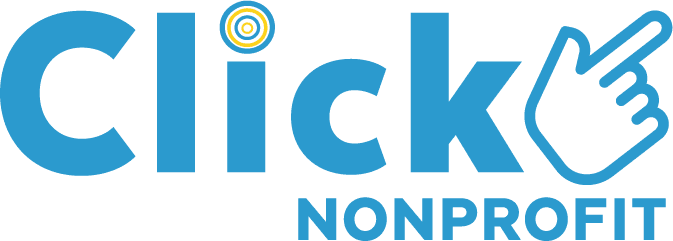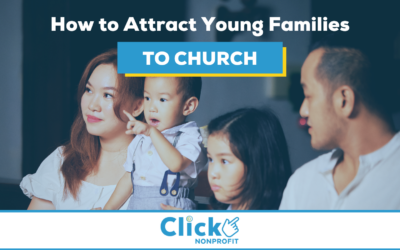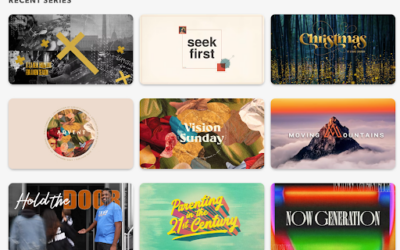Church attendance has been declining for a long time, and many churches closed during the pandemic. As we look toward 2023, churches continue their search for how to increase church attendance, even to pre-pandemic numbers.
In this post, we’ll show you how to increase church attendance by moving visitors through the church funnel and closer to Jesus.
Implement the Church Funnel to Increase Church Attendance
The sales funnel is the foundation of all retail and for-profit marketing efforts. In its most simplified form, the sales funnel consists of three steps of every customer’s buying journey. First, the customer becomes aware of the product or service. Then they consider various offerings until they convert to a buying customer. The funnel shape represents people dropping off at each step, so only a small percentage of people actually make a purchase.
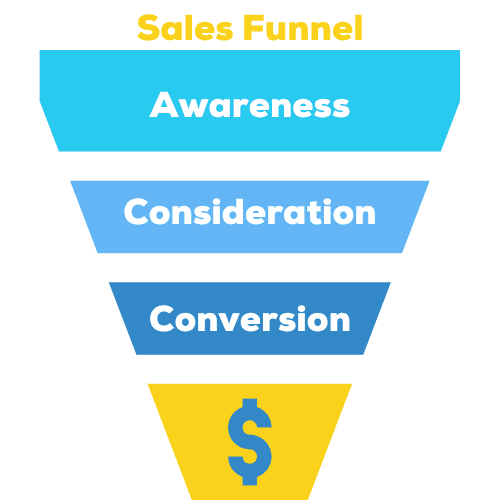
Churches exist to make disciples before money, but the funnel still applies. Pro Church Tools and Nucleus Media founder and CEO, Brady Shearer adapted the sales funnel for the church with the steps attention, engagement, and next steps. First, the church has to get people’s attention in order to invite them to engage. When the invitation is accepted, the church continues its disciple-making efforts by encouraging their members to take the next steps in their relationship with Jesus.
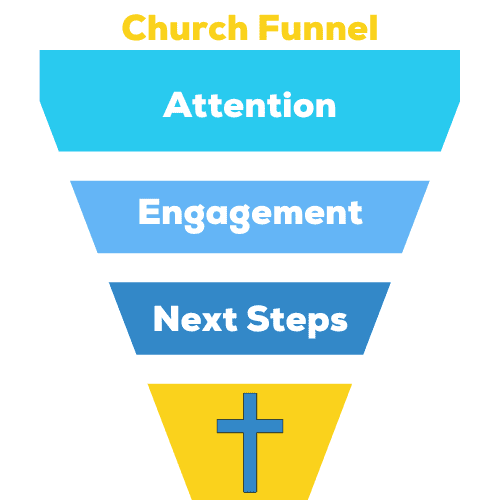
Attention
The first step is to get people’s attention. While church attendance isn’t what it used to be, Bipper Media president Bobby Holland reported more people are searching online for a church home than before the pandemic. This means there is potential to meet people at the top of the funnel by getting their attention to your church.
Brady Shearer believes you can take advantage of that traffic with a “top-heavy” marketing strategy. He advises focusing efforts on the top of the church funnel—getting and keeping people’s attention, because “We can’t engage them, and we can’t ask them to take a next step and expect them to do that next step if we can’t first get their attention.”
This is where the Google Ad Grant and Microsoft Ads for Social Impact Grant come in. Between the two grants, your church can run $13,000 worth of online ads every month to get eyeballs on your church website. When people search for answers to life’s questions and solutions to their felt needs, you want them to learn Jesus always has the answer and to discover that He can meet all their needs. Implementing ad grants with relevant keywords and engaging content will help your website catch their attention before the mindfulness practitioners.
Engagement
After you’ve got their attention, the next step to increase church attendance is engagement. However, Bobby found that potential congregants drop out of the funnel at this stage because church websites have no way to engage visitors. Most sites offer videos and blogs, but eventually visitors have no other option but to continue the scroll. There are many ways to keep visitors around, especially when you put the power of ad grant dollars behind your efforts to boost your visibility.
Your content needs to have a call to action to begin engaging with visitors. For example, you can ask readers to share, like, or comment on a post or blog, and make sure someone from the church interacts with them. These simple actions not only plant a seed in readers’ minds, but they also signal online algorithms to increase the visibility of your content.
Holland recommends engaging visitors by offering an e-book via email. You could offer different types of resources, such as a devotion, a course, a story, prayer, or Q&A with a pastor.
When someone signs up for a free resource, you can then send them an email sequence to help them learn more about your church. The email sequence serves as an icebreaker to help them become familiar with who you are and what you do. After a few days, someone from the church can reach out through email to see how the person is doing, how the church may help, or how you can pray for them.
When fueled by advertising dollars, SEO, and curated content, these engagement efforts will help cultivate the relationship and build rapport, so they’ll learn to trust you and take the next step.

Next Steps
While the first two steps in the sales funnel are similar to the church funnel, the third step is quite different. Retailers and for-profit organizations are transactional, but Jesus is about relationships. This is why Brady Shearer teaches the key to church growth is always the next step—whatever that next step is for each individual on any given day to help them draw closer to Jesus and grow in love.
We won’t go into disciple-making or faith-growth models here, but website and social media content should reflect your strategies to help believers continue to grow and get involved. To serve your members well, your content strategy will include SEO, keyword research, and ad grant dollars.
How We Help Increase Church Attendance
Ad grant dollars are a key to your church’s future—or lack thereof. We are so passionate about amplifying the impact of churches and nonprofits that we’ll acquire the Google Ad grant for your church at no cost. You can then implement the grant yourself, but if you’d like help, we’ll be there for you with certified grant management and content services. If you haven’t already, your next step is to download our guide to apply for the Google Ad Grant or the Microsoft Ads for Impact Grant or reach out for a free consultation.
